- Author
- Editorial Staff
- Subjects
- History - general
- Tags
-
- RAN Ships
- HMAS Adelaide I
- Publication
- March 2020 edition of the Naval Historical Review (all rights reserved)
By Walter Burroughs
Political upheaval
After thirty five years of a political alignment between the Solomon Islands and the Republic of China (Taiwan), on 22 September 2019 it was announced that the Pacific nation had switched diplomatic ties to the mainland People’s Republic of China in Beijing. This news was closely followed by leaked details of a 75-year lease over the entire island of Tulagi, made by the Central Province of the Solomons to the Chinese state-owned Sam Enterprise Group to develop infrastructure including a deep-water port. On 25 October the office of the Solomon Islands Prime Minister, Manasseh Sogavare, issued a statement that the lease entered into by a provincial government and a Chinese company was ‘unlawful, unenforceable and must be terminated with immediate effect’.
In the same timeframe the nearby island of Bougainville was heading for a referendum on independence from Papua New Guinea. This was held over two weeks in November and December 2019 with eleven Australian MPs and observers taking part as election monitors and two Australian Federal Police seconded to a New Zealand-led police operation to maintain security during the poll, which was conducted peacefully.
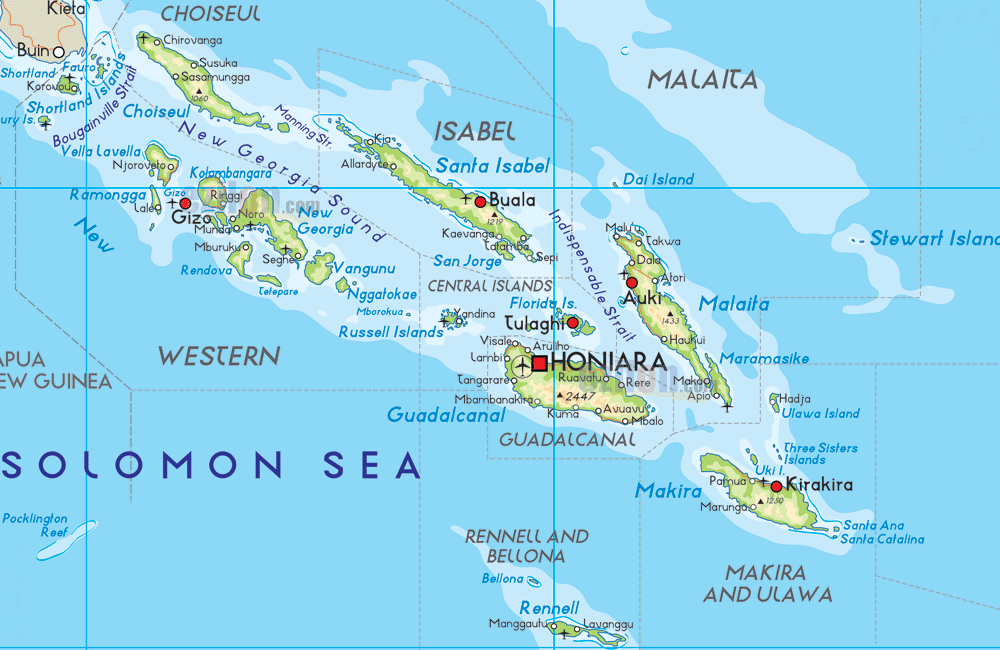
Announced on 11 December 2019, the results showed 97.7% of the 206,000 registered voters chose overwhelmingly to back independence. The non-binding referendum will now be negotiated between the Autonomous Bougainville Government, led by interim President John Momis, and the central government in Port Moresby led by Prime Minister James Marape. The process of becoming a separate nation is expected to be protracted and could take a number of years to be achieved. But when agreement is reached there will be a race for control and development of the large copper and gold resources held in this island.
The Australian Government has spent vast amounts in recent years in helping to stabilise the Solomons politically and economically. In attempting to steer a middle course and not wishing to upset either side the Australian approach appears to have produced a vacuum and lack of leadership in this region of strategic importance to the Commonwealth.
The following article has been divided into three parts: Part I discusses the Solomon Islands from European discovery to the Second World War, Part II from the Second World War to the present, and Part III addresses the history of Bougainville.
On the map
Geographically and ecologically the Solomon Islands archipelago extends from the large island of Bougainville through the chain of islands comprising the inner and outer Solomon Islands. However, politically Bougainville and nearby Banka and the Carteret Islands are separated from the remainder of the Solomon Islands.
Nowadays the Solomon Islands is a sovereign state of six major islands and over 900 smaller islands in Oceania lying to the east of New Guinea and the northwest of Vanuatu, covering a land area of 28,400 km2 (less than half the size of Tasmania) with an estimated population of 600,000. The capital Honiara is located on the island of Guadalcanal.
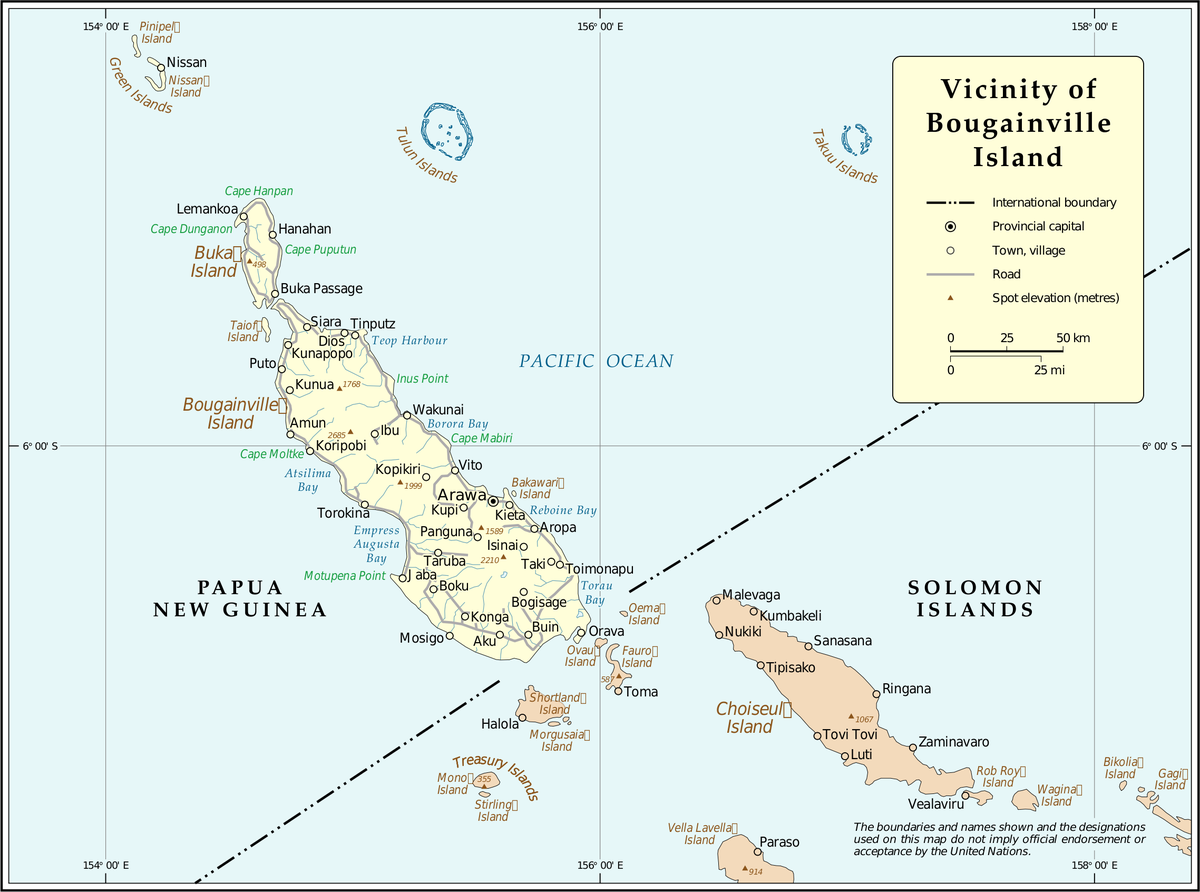
Bougainville
Bougainville Island is the main island of the Autonomous Region of Bougainville in Papua New Guinea. It is also known as the Bougainville Province of the North Solomons, which includes the adjacent Buka and Carteret islands.
Disputes over the extraction of copper and gold from the vast reserves of the Panguna mine in Bougainville led to a ten-year war, which ended in 1997, that perhaps accounted for as many as 15,000 deaths in a bitter struggle between the Bougainville Revolutionary Army and the PNG Defence Forces.
A referendum is planned for the separation of Bougainville from PNG which could make the island an independent country. With a population of only 234,000, a land area of 9,300 km2 and little experience of global governance, this may not augur well for impending stability.
Founding Fathers
The Spanish nobleman and navigator Alvaro de Mendana y Neira, a twenty-six-year old nephew of the Viceroy of Peru, was in 1567 entrusted with an expedition of two ships in search of Terra Australis. And so it was the next year he discovered a group of islands which he named Islas Salomon – in the misguided belief that, like the fabled King Solomon’s Mines, they contained vast amounts of gold. The early Spaniards were not too far off the mark regarding precious metals as the nearby Bougainville Island was later discovered to have great reserves of copper and gold. In 1595 he returned with a much larger expedition of five ships to establish a colony over which he was governor. The colony was short-lived as they failed to acclimatise and suffered from disease and from wars with the local inhabitants. The colony was abandoned with the survivors relocating to the safety of Manila.
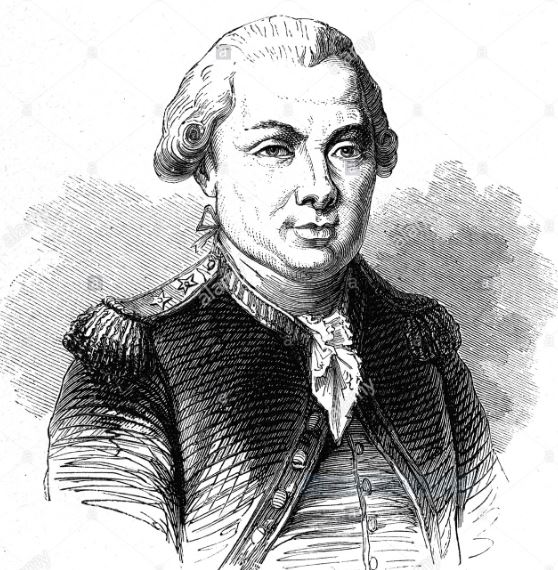
While little remembered these days, in 1766 the Admiralty commissioned an expedition to Terra Australis under the command of Captain Samuel Wallis in HMS Dolphin with Commander Philip Carteret in HMS Swallow as consort. In fog off the Magellan Straits the two ships became separated and were not to meet again. Both officers made a number of separate discoveries and in 1767 Carteret rediscovered the Solomon Islands.
Between 1766 and 1769 the French Admiral and explorer Louis Antoine, Comte de Bougainville circumnavigated the globe, sailing through the Solomon Islands but avoiding landing because of the hostility of the people. Another remarkable feature of this expedition was that of 340 men only seven died during the voyage, which in those times was an extremely low mortality rate. The important island of Bougainville is named in his honour.
In 1770 Captain Cook helped put the South Pacific on the map, leading to a permanent settlement in New South Wales with the arrival of the First Fleet between 18 and 20 January 1788, under the command of Captain Arthur Phillip. But Phillip was not alone as on 24 January two French ships, L’Astrolabe and La Boussole, under the command of Jean-François de Galaup, Comte de la Pérouse, arrived off Botany Bay1. They spent six weeks in the new colony before departing on 10 March on their return voyage to France via New Caledonia and the Solomons. La Pérouse and his ships were never heard of again and so began one of the great maritime mysteries.
It was not until 1826 that a sea captain visiting the Santa Cruz Islands in the Solomons came across artefacts thought to come from the la Pérouse expedition. The wrecks were not discovered until the early 1960s and in a reconstruction of events it appears both vessels struck reefs off Vanikoro Island with many of the crew making it safely ashore where they established a camp. As their supplies diminished and they weakened some survivors were massacred by warlike locals but others built a two-masted craft from materials salvaged from the wrecks and later set out in a westerly direction but were never seen again.
Captain Edward Edwards in command of HMS Pandora sailed these waters in search of Bounty mutineers. He passed the island of Vanikoro on 13 August 1791 and observed smoke signals. His single-minded search for the mutineers convinced him that they would not be advertising their whereabouts so he passed by, possibly missing the opportunity of becoming a hero of maritime history in solving the mystery of the lost la Pérouse expedition. Instead Edwards is remembered as an unpleasant bully and tyrant.
With the success of the settlement of New South Wales new shipping routes were being found and by the early 1800s traders began arriving in remote islands. In December 1827 there is a record of the second mate from the whaler Alfred out of Port Jackson reaching the island of Malaita and he is known to have lived there for several years, which led to a community of deserters from whaling ships residing on this island.
Lieutenant John Shortland2 was appointed naval agent for the First Fleet transports and as such the masters of these ships reported to him. After their successful arrival in Botany Bay/Port Jackson and discharge of their passengers and cargo the transports departed for England via Batavia. Shortland took passage in Alexander carrying Governor Phillip’s first dispatches from the new colony. During this voyage which was made to the east of New Guinea they briefly explored the Solomon Islands and the Shortland group (part of the Solomons) is named after him.
The Missionaries
The first missionaries to establish a presence in the Solomons were members of the Roman Catholic Society of Mary with a party of eleven priests landed at Astrolabe Bay on Isabel Island in 1845. When their leader Bishop Jean-Baptiste Epalle was killed the rest of the party relocated to Makira Bay on San Cristobal. With further distrust between locals and their guests, when three more priests were killed and others died of disease, the mission was abandoned in 1854 and not reopened until 1898.
Largely through the agency of George Augustus Selwyn, the Anglican Bishop of New Zealand, a Melanesian Mission for the Western Pacific was founded in 1850. Through these beginnings a series of mission settlements was gradually established in remote islands. A three-month cruise of the New Hebrides and the Solomons was made by HMS Havannah in 1851 with the Presbyterian minister the Reverend John Inglis embarked. The reverend gentleman described his findings to the sympathetic Governor of New Zealand, Sir George Gray, and this led to increased missionary activity.
Perhaps it is fair to say that missionaries in these parts saw themselves as moral crusaders providing education and preserving social stability in a rapidly changing environment. To the locals however they were seen as foreigners who usurped the power and influence of their tribal leaders and upset culture and customs.
Recruitment agents and blackbirders
With the discovery of gold in Australia the economy boomed and there was a vast shortage of labour. To help meet this shortfall Melanesian labourers were recruited, often violently by gangs of thugs, to work in plantations in Queensland, Fiji and Samoa. The largest component of over 18,000 coming to Queensland was from the Solomon Islands. This led to the practice of ‘blackbirding’ where schooners with armed men would sail for the Pacific islands and use whatever means possible to find labour by bribery or corruption. It was not until 1877 that the British government put in place regulations to control the trade in indentured labour in this region.
By the 1920s blackbirding, along with the introduction of firearms and disease, had left some islands, such as the 200 km long Santa Isabel (ironically the original landing place of Alvaro de Mendana y Neira) all but depopulated.
Distrust of Visitors
Captain James Graham Goodenough, who came from an ecclesiastical family, was appointed Commodore of the Australia Station in May 1873. The Commodore, while somewhat strait-laced and a keen churchman and believer in the temperance movement, was well liked and respected. One of his first tasks was to take the Governor of New South Wales, Sir Hercules Robinson, in his flagship HMS Pearl to Levuka, the then capital of the Fiji Islands. Here on 23 September 1874 the Governor declared Fiji a British crown colony.
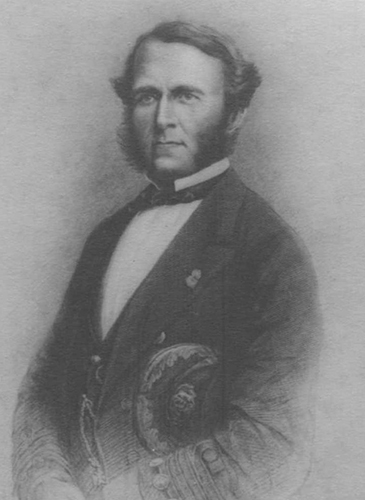
The increased responsibilities given to the Crown required it to maintain law and order in the Pacific islands. In so doing, on 12 August 1875 Commodore Good-enough was at Santa Cruz in the Solomon Islands trying to reconcile differences with natives when the shore party was attacked and the Commodore struck by a poisoned arrow. Tetanus set in and a few days later he died aboard HMS Pearl.
This was not the end of dissent. In October 1880, when the schooner HMS Sandfly was undertaking surveys and anti-blackbirding patrols through the Solomons, a party went ashore on Florida where they were unex-pectedly attacked by natives with the commanding officer, Lieutenant Commander James St Clair Bower, and three crew members killed.
European Protectorates
With European competition for influence in the Pacific, in 1884 Kaiser-Wilhelmsland (New Guinea) became a German protectorate with other island groups added the following year comprising Neu Pomerania (New Britain) Neu Mecklenburg (New Ireland) and Bougainville and Burka (northern Solomon Islands) and subsequent islands between 1885 and 1899. In 1893 Captain Gibson of HMS Curacoa declared the southern Solomon Islands a British protectorate but this was not looked upon favourably by Germany. In an agreement known as the Tripartite Convention of 1899 the Samoan Islands were divided between American and German interests and in return Germany ceased its claims upon Tonga and the southern Solomon Islands.
In 1883 the Queensland Colonial Government attempted to annex the territory of Papua in southeastern New Guinea for the British Empire. The Imperial Government refused to ratify this action but next year a protectorate was declared over British New Guinea. In 1902 the protectorate was placed under the administration of the Commonwealth of Australia under the name of Papua.
After the outbreak of the First World War in 1914, Australian troops captured Kaiser-Wilhelmsland with the Australian takeover formalised by the Treaty of Versailles in 1919. The Commonwealth assumed a mandate from the League of Nations for governing the former German territory of New Guinea (including Bougainville) in 1920 and it was administered under the mandate until the Japanese invasion in January 1942. The Solomon Islands were administered as a British protectorate, again until invaded by the Japanese in January 1942.
Traders and Planters
From early and small beginnings there have been a number of trading companies, most based in Australia, that have had a profound effect on the development of the south-west Pacific islands. The names Burns Philip, Carpenters, Colonial Sugar Refineries, Lever Brothers and the Steamships Trading Company are to be found throughout this region but many of these companies are now much diminished.
James Burns and Robert Philp began a trading partnership in 1883 and the next year, in a novel move, were the first company to offer tourism to New Guinea. The company operated as merchants and shipping agents and provided an all-important mail service to PNG, the New Hebrides and the Solomons. This highly respected company, which was a major institution in the Pacific, finally closed its doors in 2006.
Walter Randolph Carpenter, the son of an American whaling sea captain, came to Sydney in 1885. On leaving school he joined Burns Philp before starting W.R. Carpenter & Sons which operated ships and later aircraft. At the outbreak of WWII his ships and aircraft were requisitioned for government service. Walter Carpenter then went to the United States where he purchased two further ships and operated them from Canada. Later he became a Canadian citizen. Post war, the company returned to the Pacific and remains active in transport and agriculture throughout the region.
The Colonial Sugar Refining (CSR) Company, founded in 1855, was the king of the sugar industry in Queensland, northern New South Wales and Fiji. In 2010 CSR sold its sugar, molasses and ethanol business to a Singaporean company. CSR has since diversified into the production of building products.
Lever Brothers was a British company with substantial coconut plantations throughout the Pacific. Much of the product was brought to Sydney for manufacture into soap, with a major factory in Balmain which closed in 1988. The company expanded by the acquisition of a number of well-known local food brands and remains in business as Unilever Australasia.
Steamships was founded in 1918 and still survives as one of the largest landholders in PNG. It is now owned by the Hong Kong based Swire Group who amongst other assets are major shareholders in Cathay Pacific Airways.
The Voice of Tranquillity
Charles Morris Woodford, a British naturalist and explorer, first visited the Solomons in 1885 and was so captivated that he gained a government position in the then administrative centre of Fiji. He was to spend the majority of his working life in these islands. He wrote: ‘I know no place where firm and paternal government would sooner produce beneficial results then in the Solomons…here is an object worthy indeed the devotion of one’s life’. Woodford devoted his working life to pursuing this dream and became the first British Resident Commissioner in 1897. He remained in office until 1915, establishing the colonial state almost singlehandedly.
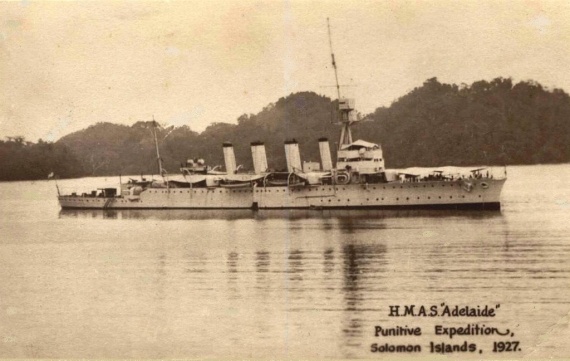
HMAS Adelaide and the Malaita Expedition
In October 1927 news was received in Australia of a native uprising on the island of Malaita in the British Solomon Islands Protectorate. This stemmed mainly from a ‘head tax’ of five shillings per annum being forced on the islanders – which was an incentive for them to work on copra plantations which were short of labour. The islanders however saw this as further inroads into their traditional way of life being imposed by government officers, traders and missionaries.
The matter came to a head on Malaita when the Australian born District Officer and his British assistant plus 15 local police were attacked by a large number of islanders when attempting to collect the tax. The District Commissioner and his assistant and nine police were killed. The surviving police fled to Tulagi, the then administrative centre, and raised the alarm. In response HMAS Adelaide and the collier HMAS Biloela, then in Sydney, were ordered to proceed to the Solomons to restore order.
After first calling at Tulagi and embarking the Resident Commissioner plus a police contingent, the ships reached Malaita on 19 October where police plus a large armed landing party were put ashore. They eventually arrested 82 men alleged to have been involved in the massacre; of these, six were subsequently convicted and hanged, while 21 others received lengthy prison sentences.
Summary
The remote Solomon Islands evolved for centuries as a Melanesian society having little interaction with the outside world with the exception of neighbouring islands. The inhabitants were fierce and warlike people, possibly a necessary characteristic in keeping away marauding tribes on the lookout for brides and slaves.
European explorers in search of the fabled Terra Australis gradually changed this society, which was decimated by European slave traders seeking cheap labour for their plantations. The initial good intentions of missionaries were viewed with contempt as they sought to bring about cultural change.
Through colonisation political boundary lines have been drawn artificially, disrupting the composition of the Solomon Islands into northern and southern groups with a dilatory influence on overall development.
Through far distant wars Australia gained colonial outposts and experience in offshore administration of large populations from different races and cultures. Trade was boosted by a number of successful companies, mostly Australian based, who made handsome profits from island plantations.
Part II of this series will examine the future of the Solomon Islands from the start of the Second World War to present times.
Notes:
- A 16 year-old second lieutenant from the Paris military academy volunteered to join the Pérouse expedition was but he was rejected. His name was Napoléon Bonaparte – the world might have been a different place had his application been successful.
- His son, also John Shortland, a master’s mate in HMS Sirius, is possibly more famously known for his discovery of the Coal River (Hunter River) and the later settlement of Newcastle.
References:
Flannery, Tim, Among the Islands, Atlantic Monthly Press, New York, 2011.
Jersey, Stanley C., Hell’s Islands – The Untold Story of Guadalcanal, Texas A & M University Press, 2008.
Lawrence, David R., The Naturalist and his Beautiful Islands: Charles Morris Woodford in the Western Pacific, ANU Press, Canberra, 2014.
Scarr, Deryck, A History of the Pacific Islands: Passages Through Tropical Time, Curzon Press, Richmond, Surrey, 2001.
Willey, Keith, Assignment New Guinea, Jacaranda Press, Sydney, 1965.




